How did this happen? The blog is 20 years from first post, and lately my attentions have been aimed at texts for weekly(ish) Convivium. I vow to figure out how to get the blog back into my day-to-day operations. Real soon now.
Maine Photographers Showcase
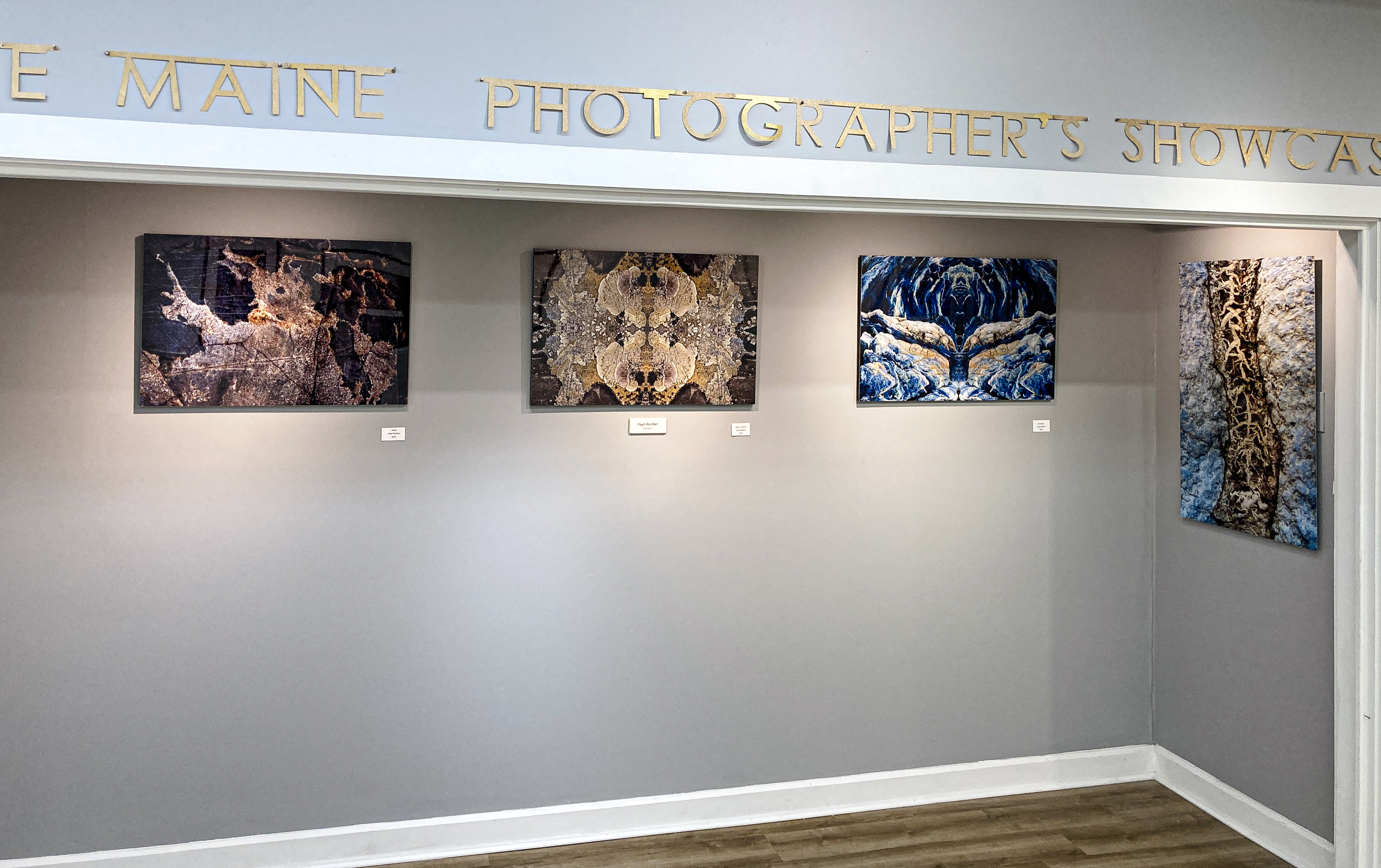
My Images for Maine Photographers Showcase, 2024
Boothbay Harbor, March 28 – May 3
at the end of January 2024
Lest January escape me, time for a salvage blog post. A lot of my writing energies have gone into texts for Convivium discussions (Solstitial Matters, Word of/for the Year, Navigating the year’s challenges, Gettin’ Above Your Raisin’, or Beyond) and of course onto the ever-growing heap of yellow pads. Various affordances await my attentions (Valoi negative scanner, CZUR book scanner, a digital microscope), each bought with specific projects in mind, and because the technologies were irresistible…), and musical plots continue to hatch, as always. I’m preparing support materials for 5 of my photographs that will be in the Maine Photographers Showcase (opening in April), and navigating the flow of new books that sloshes over the threshold. And there are always new photographic forays. So: More of Same, Piles Higher and Deeper. I intend to use the blog to track such doings more assiduously, aware that the 20th Anniversary of the blog is fast approaching.

Joerndts
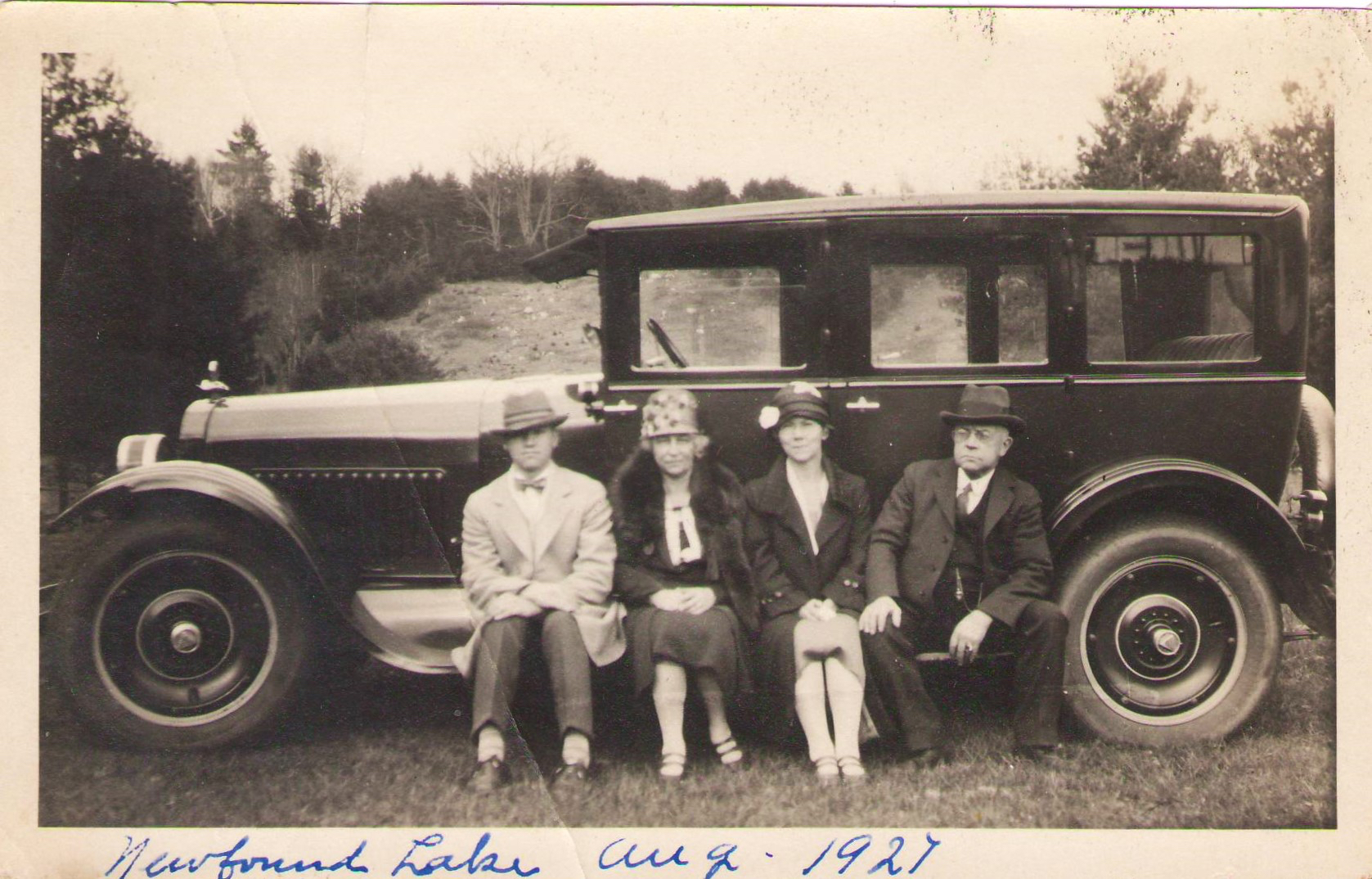
(this is just a beginning of a continuing Saga)
Photographs from the past ENCODE messages that may/can resonate across time. In fact, that’s how they work, in a sort of temporal accordion (folded up and hidden until the bellows are tugged open, then producing stored/implied/immanent/nascent SOUND). Above is a photo of my maternal grandparents, whom I have never seen pictures of. It arrived in my life this week (indirectly, from a first cousin once removed whom I’ve never met) and I’ve been working on investigating and unpacking the story it tells, and the Story it is a fragment of evidence within.
I have spent many many happy hours in the company of the Abandoned Ancestors of others, and also in my own trove of family photographs, passed down into my curatorship from earlier generations. The pleasure/game/discipline of reading images, of excavating stories, imputing personality and other characteristics, and connecting up the (sometimes fanciful) dots … is bottomless and basically harmless to anybody now living, or so I tell myself.

The people are: Carl Kikkebusch, Mary Joerndt, Harriet Joerndt Kikkebusch, and William Henry Joerndt.
What can we read from the photo? How would backstory enlarge our reading? Where does this photo fit in the catalog of genres of vernacular photographs and snapshots? [people and cars…]
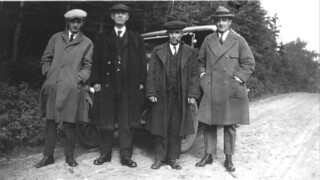
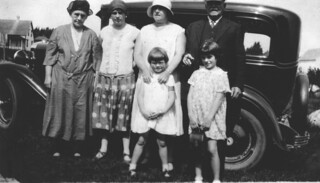
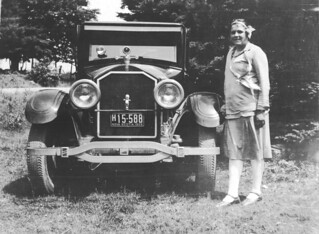
Walt Whitman would agree that these images contain multitudes —well, any image does, and the viewer’s opportunity is to explore those multitudes, all the better to deepen one’s appreciation for humanity and the vast complexities and complications of people’s lives and relationships.

So how is it that this is the only photograph I’ve ever seen of my mother’s parents, and that that seeing was just a week ago? Short answer: as I understand it, my mother was estranged from her parents from about age 14. I believe this to be rooted in a Joerndt family tragedy in 1908, resulting in the death of 3-year-old Marshall …and the subsequent divorce of the parents, evidently over the mother’s resort to various ‘spiritualisms’ in order to reach Marshall (that may be apocryphal, as may be the possible institutionalization of the mother). There’s much more to this drama, but there’s nobody left who knows.
The effect upon my mother between ages 9 and 14 was enormous and profound: her family “broken” (the term of choice in that era) around her just as she was emerging into personhood. At 14 she was sent to school at Urbana OH. Here’s how she described her state of mind:
I came here here hungry for affection, disturbed about the way I had seen people injure each other, and about as confused as a young girl can get…
Being sent to Urbana was utterly and completely the rescue that she needed:
Sixtieth year opens Sept 21, 1910
All grades from Kindergarten to second year of college
Especial attention given in regular classes
to instruction in The Word and the Doctrines of the New Church
Good, wholesome influences surrounding students
both in and out of school.
A few scholarships available
Paul H Seymour MS
Headmaster
So we find ourselves in a Swedenborgian world, in which both of my parents grew up (my father in the Boston Society) and lived their lives. Just how the Joerndts came to be in that world is a mystery, but the Humboldt Park Society of the Church of the New Jerusalem is the locus. Rob Lawson suggests
Carl and Henrietta Joerndt [William’s parents] would have been very knowledgable of the New Church German Society as early as the 1850s. The Pastor of this branch of the Chicago Swedenborgians, John Henry Ragatz, was from Switzerland and a contemporary in age with the Joerndts&mdsah;just a few years older than Carl. Ragatz started out as a minister of the Joerndt’s Lutheran Evangelical Church, of which the Joerndts remained members at least up to 1899. When Ragatz started the German New Church in 1854-55, the Joerndts may have had friends who left the Lutheran church to hang out with their Pastor Ragatz and his new-found adoption of Swedenborg’s spiritual offerings. It’s just a guess…
Aunt Harriet and Carl Kikkebusch were married in the Humboldt Park church in 1910, and at one point both my mother and her younger sister Eunice were sent to live with Harriet and Carl. Somebody in the Humboldt Park Society suggested and then managed my mother’s flight to Urbana, but I know none of the details.
Just to relieve the suspense, a few more bits of the story: after the divorce, William married again, one Augusta Knopf, who died in 1926. He then married (wait for it…) …Mary Joerndt in October 1926, in California… and both Harriet and Eunice were living in California in the early 1920s. The Mary Joerndt in the photograph

is physiognomically very similar to my mother when she was about that age.
While my mother was at Urbana, when she was perhaps 16, she had appendicitis and her father (by then a Christian Scientist) refused permission for the operation that would save her life. Alice Sturges, the Housemother, took responsibility and signed in loco parentis. Her father disowned her. Or so goes the story.
And here’s one of Mary Joerndt and Harriet in 1907: the year before Marshall’s death, when Harriet was 16:
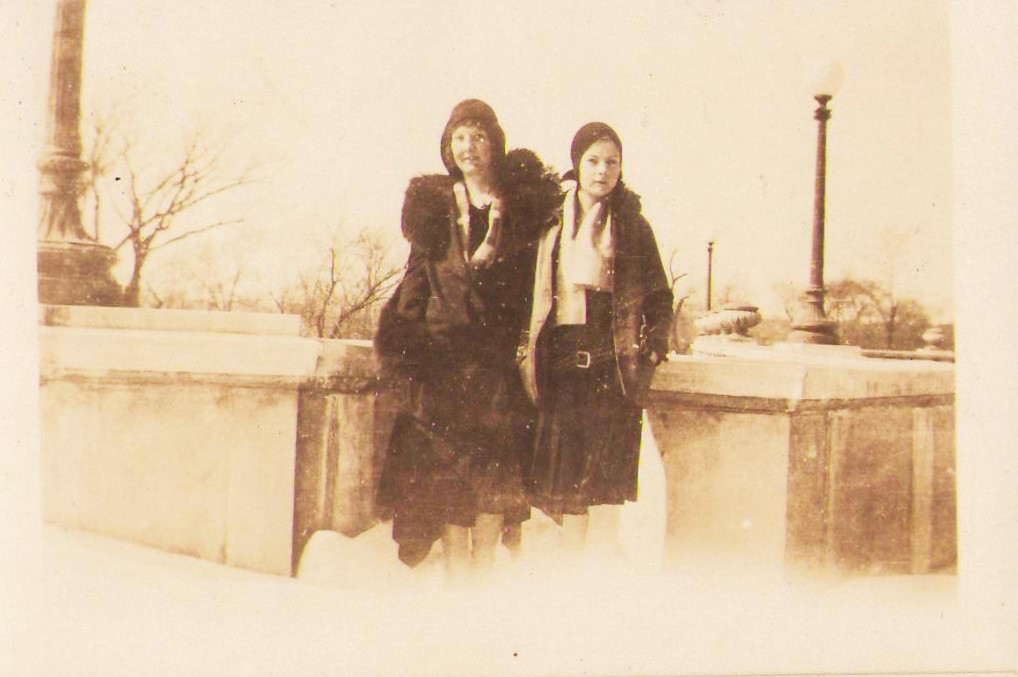
This will probably be continued, so stay tuned.
Links in the /musics directory
Again a bit of a rescue operation, a page to make accessible various documents buried on oook.info, and to inspire me to update access to musics materials.
Leonora Carrington
The day began with a YouTube video, which has Leonora in her 90s talking with her (somewhat clueless) younger cousin:
(asked if there had been other artists in the family)
LC: My mother used to paint biscuit tins for jumble sales. That’s the only art that went on in my household.Joanna Moorhead: I wonder where it came from?
LC: I have no idea.
JM: No other artists in our family? None at all?
LC: Why are you fixed on the idea of heredity? It’s not hereditary … comes from somewhere else, not from genes. You’re trying to intellectualize something desperately, and you’re wasting your time. That’s not a way of understanding, to make a kind of intellectual mini-logic. You never understand by that road.
JM: What do you think you do understand by then?
LC: By your own feelings about things …if you see a painting that you like… canvas is an empty space.
JM: If I got one of your pictures down from upstairs and said to you what were you thinking when you painted this…?
LC: No. It’s a visual world, you want to turn things into a kind of intellectual game, it’s not… the visual world, it’s totally different. Remember what I’ve just said now, don’t try and turn it into a …kind of intellectual game. It’s not… It’s a visual world, which is different. The visual world is to do with what we see as space, which changes all the time. How do I know tgo walk –that’s one concept– to this bed and around it without running into it. I’m moving in space. Or I can have a concept of it and then I can see it as an object in space…”
This is fascinating on several levels, not least the asperity of the nonagenarian being not-understood on a subtle point, and trying to convey its importance to an interviewer who doesn’t quite get it.
And that led to Adam McLean’s marvelous 6-part Study Course on Leonora Carrington:
1: The Early Years
2: Mexico
3: Celtic
4: Esoteric and Magical
5: Map of the human animal
6: Humor and Animals
(see also his Surrealism Lesson the first of 20 videos!)
and here is a somewhat younger Carrington:
“The Flowering of the Crone, Leonora Carrington, Another Reality”
And her story “The House of Fear”, read by Farah Rose:
There are lots of other Carrington videos, and see Leonora Carrington is Having A Moment from 2017, Carrington’s centennial year.
Much more awaits me…
Rescuing some files
In the root directory of oook.info I found a bunch of html files that would be lost forever if I didn’t link them somehow and somewhere, so several hours of messing with them has yielded a chronological table. At least this should make them a bit more findable, and they make an interesting map of some activities during the last 20+ years.
Basil on October 27th!
 “>
“>
Almost unheard of, but welcome.
Alter Egos
The game of following the twists and turns of my attention is a personal delight, though perhaps following my Narrative of discoveries and divagations is not an activity that many would find amusing or useful … so this is self-indulgent and primarily for me, to try to capture the daily process. And why not blog it, just in case it might edify or inspire, and so I can find the bits and pieces again myself.
Today’s hypnopompic prompt [waking thought] was centered on the notion of the alter ego (the term said to have been coined by Cicero [‘second self; a trusted friend’]), perhaps touched off by recent explorations of surrealism, and an offshoot of 3 weeks of exploring dreams and dreaming, but a phenomenon of considerable long-running personal interest.
The centerpiece of the moment is Max Ernst, whom I knew had adopted an alter ego, whom he called Loplop, and represented as “Father Superior of the Birds” (the Wikipedia article is a good starting place)
Loplop first appeared in Ernst’s collage novels La Femme 100 Têtes and Une Semaine de Bonté in the role of a narrator and commentator, followed by a number of works into the mid 1930s, forming an informal series of collages, paintings, and mixed media works.
Loplop’s image was not a fixed character, but highly variable in appearance and seldom depicted in the same way twice. Typically (but not always), Loplop had the head of a bird, which could be highly abstracted, often a bird with a crest, comb, or wattle. The body was a square or rectangular space (a canvas, frame, easel, or wall), with the arms and legs being zoomorphic or geometric abstraction in form. Within the “body”, an image, a piece of Max Ernst’s art is presented (a collage, frottage, painting, etc.) which could be equal to, or function independently from the rest of the work.
I first encountered Max Ernst as the subject of a photograph by Frederick Sommer, seen ca. 1964 in Aperture, long before ‘surrealism’ became a subject for my detailed exploration.

(and see fredericksommer.org for how the image was constructed)
Quite a few of Sommer’s photographs were enigmatic and weird enough to draw my attention 60 years ago, as an aspiring photographer on the ragged edges of the conventional, and the Max Ernst photograph seemed at first pretty transgressive of my notions of ‘normal’ portrait images.
So Max Ernst: here’s some of what I collected today, and am working over
from MoMA:
Beginning in the early 1930s, Loplop, or “the Bird Superior,” became one of Ernst’s favorite alter egos. Here his beak-like profile peers over the top of a large rectangular field, which resembles a canvas on an easel or a sandwich board, held up by a concealed body with two stubby feet. In place of a painting or commercial slogans or graphics, Ernst substituted carefully cutout photographs of members of the Surrealist group. His own face appears just slightly above and to the left of center, right next to Salvador Dalí. Such pictures of collective or group activity are a persistent theme in Surrealism.
(fromGallery label from Max Ernst: Beyond Painting, September 23, 2017-January 1, 2018)
Max Ernst and Birds (Daily Art Magazine)
Max Ernst: a retrospective pdf from archive.org/details/maxer00erns
Summary of Max Ernst “Inspiration to Order” Mike Busby
A Week of Kindness: Exploring Max Ernst’s Surrealist Visual Novel Une Semaine de Bonté
The enduring significance of the work of Max Ernst
History of a Natural History: Max Ernst’s Histoire Naturelle,
Frottage, and Surrealist Automatism (pdf)
…and I have La Femme 100 Têtes and Une Semaine de Bonté on order…
But what about the alter ego that I began with today? My fascination with such beings is based in my very own engagement with alter egos, the ‘Pogo’ that has followed me since 1953, and the ‘oook’ that joined the parade in the early 1990s (via Terry Pratchett’s Librarian). It’s not so much that either of those is me, as that I have identified with aspects of the characters for 70-odd and 30-odd years. It doesn’t seem to me that many of my acquaintances have similar relationships, and I’m curious about that. There are plenty of examples in literature (even Superman and Batman, whom I abhor…). And now with AI, anybody can have the wherewithal to design avatars and turn them loose in cyberspace … and of course there’s a TV series (Thanks, Fox…) Alter Ego, Avatars and Their Creators and ‘Legitimately nightmarish’: is Alter Ego the worst TV show of 2021? (Guardian). And there’s the 2009 film Avatar , which has spawned a franchise…
A long way from the playfulness of Max Ernst’s Loplop.
“Avatar” comes from the Sanskrit word avat&amacron;ra meaning ‘descent’. Within Hinduism, it means a manifestation of a deity in bodily form on earth, such as a divine teacher. For those of us who don’t practice Hinduism, it technically means “an incarnation, embodiment, or manifestation of a person or idea”. But in the West, because we mostly encounter avatars in the digital space, we generally define them as the little cartoon person you choose to represent yourself in video games, on social media, or in web forums.
And in the Metaverse?
Avatars are a digital expression of you, letting you freely express your identity, personality and appearance. Avatars are available across all first-party Meta experiences, including those in VR.
eeeeek.
…and there goes September
It’s been a momentous month, or anyhow a month of moments, what with the last days of John and Laura and Kian’s visit, our 59th wedding anniversary, my 80th birthday (something definitely watersheddy there), the annual mileposts of my mother’s birthday (her 124th) and sister Alice’s death day (the 13th) …and preparations for a hurricane that went to Nova Scotia instead, an invitation to participate in a photography show in Portland in November, a decision to not spend $9K on a tooth replacement, resumption of contact with Adrian Lewis (last heard from 20+ years ago), participation in nephew Nick’s difficult move from one house to another (the most horrible physical experience memory can summon), health crises of an old friend and spouse, and then being laid low myself by the COVID I’ve been successfully dodging for 3 1/2 years, and and a locally world-altering fire in Port Clyde just two days ago…
Lots of reflection on advancing age and the anthropology I’ve laid claims to as an Identity for about 60 years, and the usual excesses of reading and writing, some of it epistolary, and a lot having to do with a Convivium Question on dreams and dreaming that was postponed twice… . Dipping into Jung, into Anthony Powell’s epic Dance to the Music of Time (which I hadn’t the perspective to finish 50 years ago), into Surrealism, into several intersecting literatures of Mind, into several David Mitchell books.
This is the sort of discovery that gives me pleasure, found in a London Review of Books article on the Hudson’s Bay company:
When Elizabeth II visited its former territories in Manitoba, The Hudson’s Bay Company governor presented her with the gift its charter mandated for a visiting sovereign: two live beavers, which promptly copulated in front of her…
and a marvelous description of a somewhat sad character in Anthony Powell’s At Lady Molly’s:
…He also gave the impression of an old dog waiting to have a ball thrown to retrieve, more because it was the custom in the past than because sport or exercise was urgently required…
Tomorrow is sure to bring further delights and distractions.